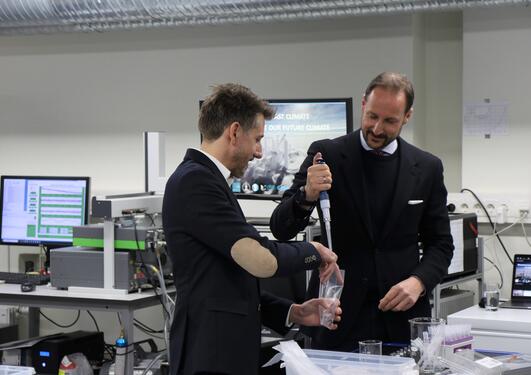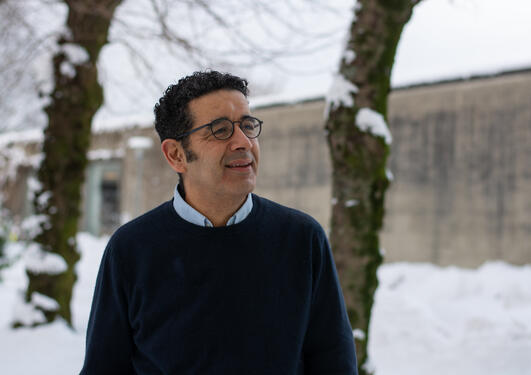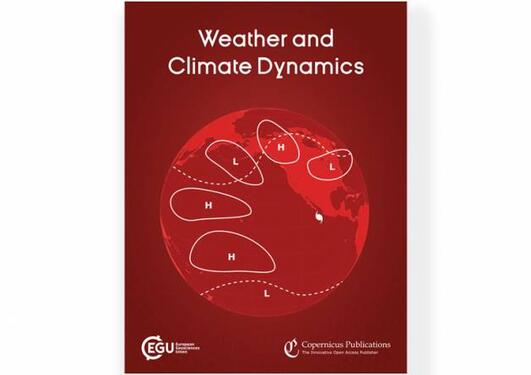News archive for Climate Dynamics
HRH Crown Prince Haakon of Norway visited the Bjerknes Centre to learn more about our research – and to check the snow he sampled himself in Greenland last summer.
The circulation in the North Atlantic Ocean can dampen temperature increase and ice melt in certain decades. Researcher warns against interpreting reduced temperature increase as a sign of a slow-down in climate change.
Neste uke inviterer Erica Madonna både menn og kvinner til å diskutere om like muligheter i forskningen.
Observations north of Svalbard reveal a pathway of energy transfer from tidal currents to turbulent mixing.
The structure and transport of the slope current at the Lofoten Escarpment are described for the first time using 14-month long mooring records.
Four SDG14 targets are maturing in 2020 and with the University of Bergen's leadership in ocean science and sustainability, the university will take these targets to decision-makers over the course of the upcoming year.
The yearly lecture at the Norwegian Academy of Letters and Sciences.
In the mid-latitudes the weather changes quickly. Changing winds influence the heat exchange between the atmosphere and the ocean. A new study by Fumiaki Ogawa and Thomas Spengler shows how important it is to consider short-term phenomena like extratropical cyclones and cold air outbreaks when calculating air-sea fluxes. Read their account below.
In a number of European countries, there is a clear imbalance between long-term disaster risk reduction and short-term preparation, according to a new study. With increasing amounts of data, there is a potential for investments in long-term reduction measures, but data availability is not enough. Jenny Sjåstad Hagen, co-author of the study, writes about the importance of data interoperability.
What are our safe operating spaces for the ocean? This is the starting question for the new EU Horizon 2020 project COMFORT.
The location of the jet stream influences European weather at all times. A new study links its position both to local weather systems and to the far-away Pacific Ocean. Lead author Erica Madonna explains.
How can the academic community make an impact to get vital information on climate change across to decision-makers? By engaging in the type of quiet science advice provided by Benjamin Pfeil and his team at the University of Bergen.
Camille Li is editor for the new open-access EGU publication.
Climate simulation models include more and more processes – not only physical, but also biogeochemical cycles. Can single individuals keep an overview of the major factors governing climate change? Christoph Heinze has led a study that can help you. He presents the new article here.
Evaporation demands energy, condensation releases energy. Both can affect the development of midlatitude cyclones, often associated with clouds and rain. A new study addresses how evaporation of rain contributes to cyclone development. Lead author Kristine Flacké Haualand explains.
Allocations from the Academy Agreement between UiB and Equinor were announced on 28.06.2019. Four research projects on offshore wind received funding. In addition BOW was allocated funding for two Associate Professor II positions.
«The mid-latitudes are one big, chaotic mess”, says Camille Li.
Pages
- March 2023 (1)
- January 2023 (1)
- March 2021 (1)
- August 2020 (2)
- January 2020 (2)
- November 2019 (1)
- October 2019 (4)
- August 2019 (2)
- July 2019 (2)
- June 2019 (1)
- May 2019 (3)
- April 2019 (2)
- March 2019 (3)
- February 2019 (1)
- January 2019 (3)
- December 2018 (2)
- November 2018 (1)
- October 2018 (2)
- September 2018 (2)
- August 2018 (1)
- July 2018 (1)
- April 2018 (2)
- March 2018 (2)
- February 2018 (2)
- January 2018 (1)
- October 2017 (2)
- June 2017 (4)
- April 2017 (1)
- March 2017 (1)
- February 2017 (1)
- December 2016 (1)
- November 2016 (1)
- August 2016 (1)
- May 2016 (2)
- November 2015 (1)
- October 2014 (1)
- September 2014 (1)
- June 2014 (1)
- December 2013 (1)
- November 2013 (1)
- October 2013 (1)
- September 2012 (1)
- February 2011 (1)
- January 2011 (1)

















